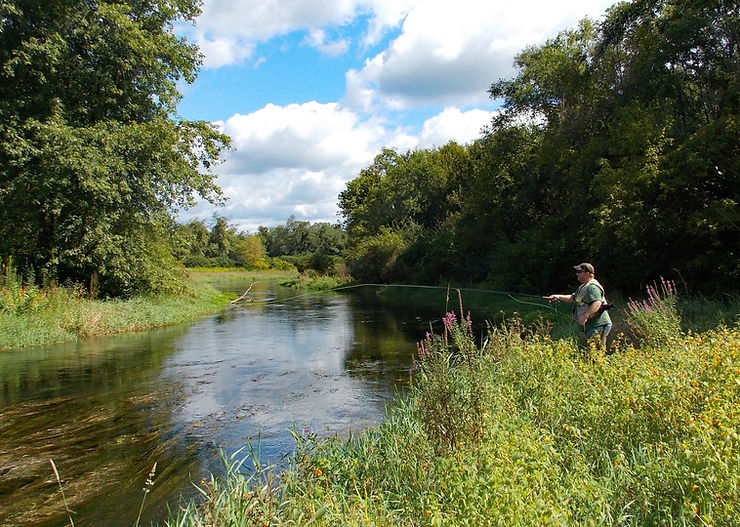Hallowed Waters – Letort Spring Run

Online I read a blog post by a well-known fly fisherman who has visited Letort Spring Run half a dozen times and has yet to catch a fish. The Letort doesn’t give up her bounty without a fight. If the weeds don’t foil your efforts, overhanging branches will. But if you can get your fly in the water and avoid the watercress and elodea, and watch out for branches, and sneak up to the water’s edge and get the perfect drift without spooking fish, then you can catch some beautiful wild browns. Theoretically.
Indeed, the allure of what could be is what attracts anglers. That and the need to be humbled, or else prove one’s skills on famous waters where legends have fished. Any fool with an appreciation for our heritage should want to do the same, if not just to see those hallowed waters, then at least to cast to the ancestors of the trout that served as the test subjects for modern dry fly tactics and terrestrial fishing.
Just as famous as the fish are the pioneers, among them Vince Marinaro, whose ashes were sprinkled into the Letort from a railroad trestle in March of 1986. Marinaro authored two books, In the Ring of the Rise and A Modern Dry-Fly Code. A quote from the latter appears on his memorial along the meadow that bears his name: “The Letort is a hard taskmaster and does not treat lightly any violation of dry fly technique.”
Time has not made the fishing any easier. Letort Spring Run ranks up there with Henry’s Fork out west as one of the toughest streams in the country in which to catch a trout.
Many factors contribute to this, first and foremost being that the stream has not been stocked in decades. The wild browns that live there are wary, to say the least. One errant shadow on the water is enough to send fish diving for cover and not come out again for days. Also, being famous waters, it is a rite of passage for every fly fisherman to fish the Letort, which translates into an extraordinary amount of pressure every year, all year long. Although many will leave without ever landing a fish, they will have educated countless wild browns just by trying.
History has not been kind to Letort Spring Run, either. The stream flows around and through downtown Carlisle in Cumberland County. In the early 1900s, the stream battled through bouts with raw sewage and frequent flooding. Businesses were built and a booming town grew up around the stream. Despite all of this, trout thrived in the Letort throughout the middle 1900s. And then, in May 1981, an endosulfan (pesticide) spill at the watercress farm near the headwaters caused massive die-offs of fish, insects, and other wildlife, and the stream has never completely recovered.
Rather than restock the Letort, the PA Fish & Boat Commission decided to allow the surviving fish to reproduce and repopulate the stream. To some extent, this has proven successful, and stream surveys have suggested good reproduction rates are taking place. However, it’s a slow process. Not to mention, because of the spill, we’ll likely never again see the blizzard-like mayfly hatches that the Letort was once famous for, a heartbreaking thought that only reinforces the importance of conservation and protection for our coldwater resources.
Today, the Cumberland Valley Trout Unlimited is working hard to restore the Letort to its previous glory through various steam improvement projects and efforts to reduce the amount of siltation that chokes out natural vegetation. The Central Pennsylvania Conservancy is in the process of acquiring the 30-acre tract of land that was once a commercial watercress farm. This acquisition will provide a much-needed buffer between the effects of human encroachment and the Letort’s headwaters and is critical for the survival of the stream for future generations. To make a financial donation toward the purchase, visit www.centralpaconservancy.org. You can also support the project with the purchase of the book The Letort: A Limestone Legacy.
It’s said that the flow is about half of what it was 50 years ago, when the Letort was in its heyday. Urbanization requires water to flourish, after all. Water drawn from wells and aquifers is used and disposed of through sewage lines and never returns to the springs which give the stream life. The lower volume alone makes this generation of trout much harder to catch than their ancestors. Talk to many local fly fishermen and they’ll tell you that the Letort is good for a token visit while you’re in the area, but if you want to actually catch fish, Yellow Breeches or Big Spring are much better options.
Remarkably, though, good fishing can still be had, and access to the stream is plentiful thanks to conservation groups as well as the PA Fish & Boat Commission. If you can forget for a moment that civilization is so close, and if you can block out the constant hum of traffic on the PA Turnpike, which crosses the lower end of the stream, then you can stand among the wildflowers on the banks, with the morning sun on your face, and watch the water glide by and almost feel the ghosts of all those legends who once fished there, too.
On a trip to the Cumberland Valley in September 2017, I spent an hour or so of my first morning on the Letort before heading to Big Spring and Yellow Breeches. I glimpsed a nice brown hugging the stream bottom at the Letort, camouflaged among the elodea, and then it was gone. It was enough to make me go back for a few hours before heading home two days later. Besides, I just wouldn’t feel right leaving the Cumberland Valley without giving myself at least a reasonable chance to catch a fish on the legendary Letort Spring Run.
I arrived at the stream while it was still dark and walked carefully downstream without making a cast, just observing, hoping to see a fish rise to a bug of any kind. The stream is so choked with vegetation in some spots that fishing a subsurface fly is almost impossible. If you keep your casts short and place them perfectly in the little runs between patches of elodea, you can have success, but it will be hard-earned. By far, dry flies are the easiest way to catch fish there.
Eventually I came to some areas where the vegetation was sparse and I could see wide gaps with sand and rock bottom. I spooked several trout, despite moving slowly and keeping low to the ground. Even when I did get up on a piece of water undetected, my casting motions often foiled me. Also, with so much brush crowding the stream, there’s just no easy, subtle way to get your fly to the fish.
Finally, I pushed my way through some brush, crept up on a pool, and found myself eye to eye with about a 16-inch brown. He was long and pale and beautiful, and didn’t see me until I tried to drop a fly in front of him. Then he shot upstream and bolted around the pool before settling in the shadows near the opposite bank. A minute later he moved up alongside a rock in the stream and slowly disappeared underneath it.
I stood there for perhaps ten minutes before making my next move. In that time, my eyes adjusted and I spotted at least three other fish hugging the bottom. When I tried for them, though, they darted around the pool and that was that, so I left.
When I returned a half hour later, I got up on the pool unnoticed and stood against a tree. A trout rose for some sort of bug. I tied on a size 20 green caddis. I flicked the line out into the current and a small brown shot up from the bottom and swiped the fly. I set the hook, but no fish. I cast again, and another small fish hit, and again when I set the hook there was nothing there. I’d been too excited, and instead of allowing the fish to take the tiny fly in and eat it, I’d pulled it out of its mouth. Determined to be more patient, I tried again, but the fish were done with the green caddis.

That’s when I noticed a light-colored caddis fluttering in the air. I tied on a tan, size 14 elk hair caddis and cast it to the head of the pool. As it floated down and over the fish, one of the bigger browns took notice and attacked the fly. After a short battle, I brought the trout to my hand and admired its wild beauty. The browns in the Letort are unlike any others I’ve ever caught. They have very few spots, comparatively, and vibrant yellow bellies. They’re little gems, rare and beautiful, and I was grateful to have landed one.
After releasing the fish, I hooked up my rod and hiked back to the car. My experience on Letort Spring Run was now complete. I caught one, almost two. Almost. Some people would say that justifies a return, but I know when to leave well enough alone.
Sign up for the Dark Skies Fly Fishing e-newsletter
It's free, delivered to your inbox approximately three times each month. Your information is always kept private and used for the sole purpose of keeping you up to date on blog posts and specials in the online store.
Sign Up Now
Ralph. I am really enjoying your site and appreciate the detail, particularly of the northern tier. I live in State College and am part of the committee that organizes the annual On The Fly Tournament to benefit Children and Youth Services. This May will be our 29th annual. We have a number of guides and local businesses support us with in kind donations and sponsorship. If it would expand your reach to over 140 fly fishermen/women, we would love to have Dark Skies participate. We have some sign sponsorships from $100, and also greatly benefit from a 1/2 day or full day of guide time that we raffle off. Happy to feel you in if you think this is something you’d be interested in being part of. Best of luck w/ Dark Skies.
https://ccysb.com/events/on-the-fly-pa-fly-fishing-tournament/